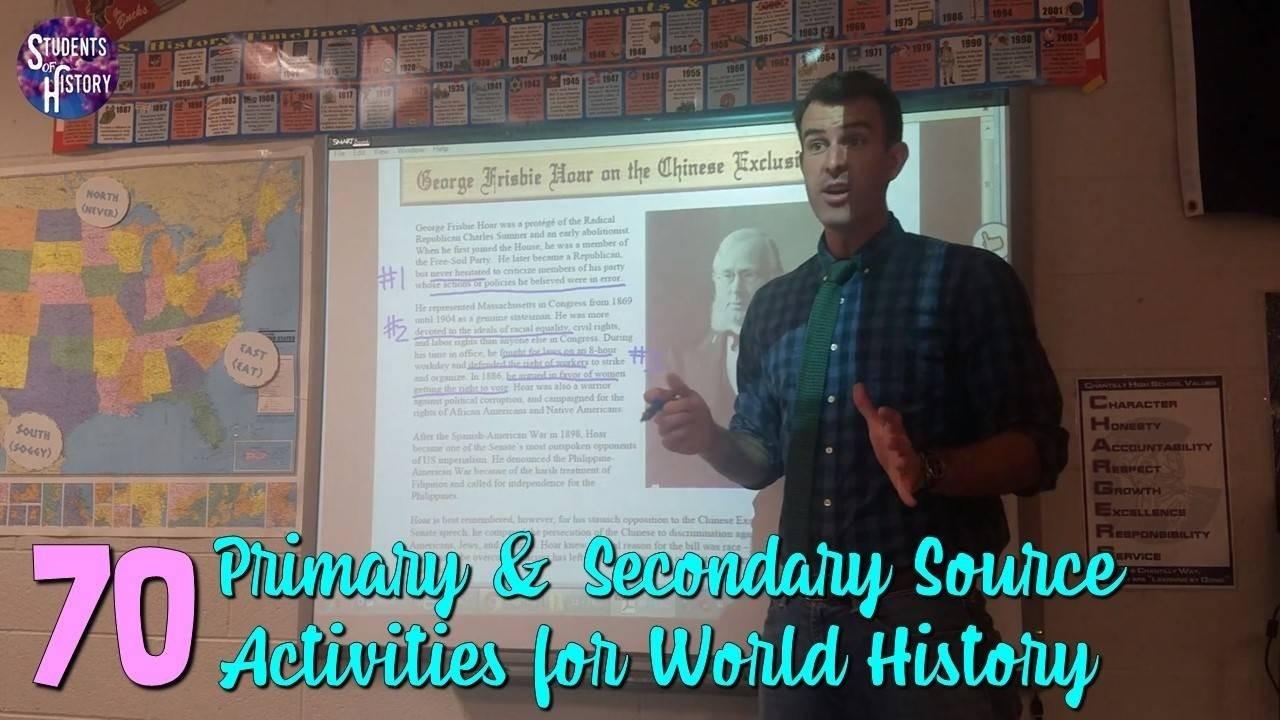70 World History Primary and Secondary Source Activities

The benefits of using primary sources in the classroom have long been known to social studies teachers and education leaders. Whereas bias can misinformation can sometimes be found in textbooks or online sources, primary source activities allow students to directly analyze and interpret history.
Primary Sources expose students to different perspectives in World History and allow them to draw conclusions about important historical events.
Secondary sources are valuable as well. These can be used to introduce students to a topic, provide context to historical events, and ensure that students understand the major people, places, and events of a topic.
An important aspect of teaching social studies is blending good primary and secondary sources into all of your units while making sure that students understand the differences (and benefits) of both.

A difficult part of that for many teachers is finding good primary and secondary sources that students can understand. Often primary sources are at a higher reading-level that students might struggle with. Secondary sources as well could be overly long, too short, or biased in a way that make them inappropriate for the classroom.
During the course of my 15+ years teaching, I dedicated myself to curating and editing engaging primary source resources for World History. I've spent hours researching to discover resources for each unit that can be understood by students.
I've also written and edited secondary source "informational text" articles for World History. These are almost always 1-page and include analysis and comprehension questions to ensure students understand the article.
At the beginning of the year, we will practice understanding the differences between primary and secondary sources along with covering other historical thinking skills.

Then, in each unit in World History my classes will analyze both primary and secondary sources. I've linked 70 of them below if you'd like to check them out or use them in your classes. They're organized by eras and broken up by primary and secondary sources:
Ancient History Primary Sources
- Hammurabi’s Code
- Ancient Egypt’s Book of the Dead
- Ancient Egypt & Hittite Treaty
- The Ballad of Mulan
- The Analects of Confucius
- Alexander the Great Source Analysis
- Gladiators in Ancient Rome
- Justinian’s Code
- Byzantine Empress Theodora Speech
Ancient History Secondary Sources
- The Ice Age and Stone Age
- The Origin of Early Humans
- Ancient Egypt's Kingdoms
- The Persian Wars
- Roman Gods and Mythology
- Pompeii and Mt. Vesuvius
- Ancient China
- The Great Wall of China
Middle Ages to the Modern World Primary Sources
- Serfs and Feudalism
- Middle Ages Meme Project and Stations Lesson
- Anne Boleyn’s Letter to Henry VIII
- The Daily Schedule of Louis XIV
- Divine Right, Absolutism, and the Enlightenment
- Vasco da Gama and Exploration in India
- Crimes of the Spanish Conquistadors
- Understanding Mercantilism Project
- Comparing the Declaration of Independence & Declaration of the Rights of Man
Middle Ages to the Modern Secondary Sources
- Understanding the Magna Carta
- Feudalism and the Manor System
- Joan of Arc
- Medieval Knights and Chivalry
- Martin Luther and the Reformation
- Ferdinand Magellan
- Ponce de Leon and the Fountain of Youth
- Absolute Monarch King Louis XIV's Daily Schedule
- The Irish in Barbados
- The French Revolution and the Guillotine
- Simon Bolivar and Revolutions in Latin America
- Anita Garibaldi and Nationalist Movements
- Toussaint Louverture and the Haitian Revolution
- The Effects of the Industrial Revolution
Imperialism, World War 1, & the Interwar Era Primary Sources
- Opium War Letter to Queen Victoria
- Matthew Perry’s Expedition to Japan
- Menelik II Letter to the Berlin Conference
- Tokugawa Japan Reading and Document Analysis Activity
- Industrial Revolution Child Labor Story
- The Boxer Rebellion in China
- Imperialism and Independence for the Philippines
- World War 1 Propaganda
- World War 1 and German Loyalty
- Mao Zedong’s Communist Posters in China
Imperialism to the Interwar Era Secondary Sources
- Liliuokalani Last Queen of Hawaii
- Smedley Butler and American Imperialism
- The World War 1 Christmas Truce
- The Russian Revolution
- Mohandas Gandhi
World War 2 and the Cold War Primary Sources
- Appeasement and World War 2
- Japanese Internment Camp Letter
- President Truman on the A-Bomb
- The Korean War from North Korea’s Perspective
- Nikita Khrushchev Speech & Secret Letter
- Vietnam War Soldier’s Letter
World War 2 and the Cold War Secondary Sources
- Kristallnacht and the Beginning of the Holocaust
- The Nanking Massacre
- Hiroshima and Nagasaki Atomic Bomb Survivor
- The Last Japanese Soldier to Surrender
- The Cold War
- The Fall of the Berlin Wall
I hope you find some of those resources helpful for you in your teaching!
If you think you could use many of them, you can also sign up to join Students of History and you'll gain immediate access to ALL 65+ primary and secondary sources with your World History subscription!
Joining also gives you access to lesson plans for every day, PBL, interactive notebook activities you can pair with these documents, digital notebooks, flipped classroom videos, and much more!

Want to try some lessons for free?
Try out some free lesson plans and resources for your social studies classroom!
Don't worry, your information is never shared.